Beyond Perfect-Bound
Is it time to expand our idea of the poetry book?
BY Michael Dinsmoor
In the spring of 2009, Chapman University in Orange, California began Tabula Poetica, a wide-ranging educational project dedicated to the collaborative exchange of ideas about poetry. Jen Bervin and Nancy Kuhl, both of whom have participated in poetry publishing outside the production of full-length books, were among the project’s first visiting poets.
Jen Bervin's artist book The Desert(Granary Books 2008)—and its five thousand yards of blue thread—reside in thirty special collections. including The J. Paul Getty Museum, The British Museum, Stanford University, Bibliothèque Nationale de France, and the Library of Congress. Her other books include Nets (Ugly Duckling Presse, 2004); A Non-Breaking Space (Ugly Duckling Presse, 2005); The Red Box; and Under What Is Not Under Poets and Poets, 2000).Bervin's exhibitions include "Black Pages" at Shandy Hall in York, England; "On Clouds" at Observatory in Brooklyn; and "Threads" at The Center for Book Arts in New York. Her work has been shown at The Walker Art Center, The Soap Factory, The Wright Exhibition Space, and The Camargo Foundation in Cassis, France.
Nancy Kuhl’s second full-length collection, Suspend, is forthcoming in 2010 from Shearsman Books, which published her first full-length collection, The Wife of the Left Hand (2007). She is the author of two chapbooks: The Nocturnal Factory (Ugly Duckling Presse, 2008) and the Wick Poetry Chapbook Prize winner In the Arbor (Kent State University Press, 1997). Kuhl’s work is included in the limited-edition artist’s book Means of Securing Houses &c. from Mischief by Thunder and Lightning (Propolis Press, 2009). She is the author of two exhibition catalogs: Intimate Circles: American Women in the Arts and Extravagant Crowd: Carl Van Vechten’s Portraits of Women, both distributed by Yale University Press. Kuhl is co-editor of Phylum Press and Curator of Poetry for the Yale Collection of American Literature at the Beinecke Rare Book and Manuscript Library at Yale University.
Jen Bervin visited the Chapman campus on April 21, 2009 for a poetry reading and a talk about her intertextual work, particularly in relation to Emily Dickinson’s poetry. Nancy Kuhl visited campus on April 14, 2009 for a poetry reading with Richard Deming and a talk about the poets’ artifacts held at Yale University’s Beinecke Library. After their visits to campus, Chapman University MFA students Andrew Mauzey and Michael Dinsmoor conducted the following interview with the two poets via e-mail.
* * *
Andrew Mauzey: Each of you has published—or exhibited—work outside the production of full-length books. A lot of this work has been in chapbook form. What do you think chapbooks offer?
Nancy Kuhl: Among the many possibilities, I think the chapbook is one of the best formats for the publication of poetry. My thinking has to do in part with the fact that the chapbook’s length allows both writer and reader to focus, to sustain a sometimes intense, suspended attention from the work’s beginning to end, something that isn’t always easy or even possible with a longer collection, especially in our cacophonous, information-saturated lives.
Even more, I love the way the chapbook form, its smaller size, encourages hand-to-hand exchange. The chapbook presents us with a kind of literary imperative that seems to me less common in full-length collections of poetry. As a poet deeply invested in small press traditions and practices, I know from experience that it is primarily chapbooks that both poets and small poetry publishers press into readers’ hands, saying, You must read this book. No, I mean read it now. I’ll wait.
Andrew Mauzey: When I think about the growing interest in alternatives to the full-length poetry collection (chapbooks, artist books, websites, and so on), Frank Bidart’s Music Like Dirt, the first chapbook to be nominated for a Pulitzer Prize, comes to mind.
Nancy Kuhl: Bidart’s Pulitzer nomination may indeed have called attention to chapbooks, but this format and a wide variety of alternatives to full-length poetry collections and to more commercial publishing have long been thriving on the American poetry scene. Emily Dickinson’s fascicles are an early example, as is the first edition of Whitman’s Leaves of Grass, along with many of the great American books of the Modernist period, including the Black Sun edition of Hart Crane’s The Bridge with photographs by Walker Evans.
Jen Bervin: I’m glad you mentioned Dickinson’s fascicles because her manuscript groupings feel considered from inner necessity. Some private coherence the poems called for and the simple act of a stitch. Why are these 21 poems held together? Those 10? Or those 8? If those decisions are in the poet’s hands, she can respond purely to the work, to what its needs are.
I’ve been tracking a single poem of Dickinson’s: “A Route of Evanescence.” She sent it out to correspondents six times over the course of four years, each time with very subtly altered line breaks, the poem accompanied by a note like “Please accept a Humming Bird.” The poem begins, “A Route of / Evanescence / with a + delusive / wheel—” In her private draft she includes three variants for delusive—“+ dissolving, + dissembling + renewing”—but in all six letters, she sends it out “with a revolving / wheel.” I love best what the poem was able to do in her completely private form, and yet I value the subtle changes she brought about in the letters. Connecting with an audience can be very affecting to a poem or a work.
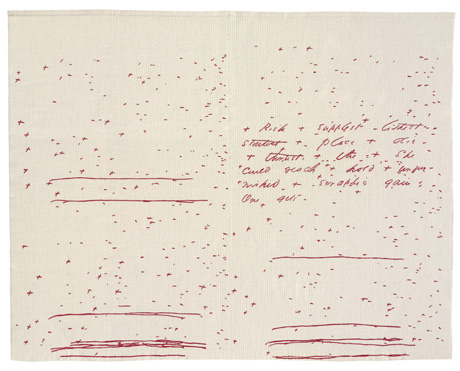
Jen Bervin, The Composite Marks of Emily Dickinson's Fascicle 28.
Embroidered red silk thread, machine sewn gold thread for light rule, cotton batting backed with muslin. 6 ft h x 8 ft w. 2007.
Michael Dinsmoor: It is true that decisions are in the poet’s hands in this example. But is it not also true that the poet is, in some way, responding to or at the very least aware of an audience? And doesn’t audience expectation change with factors like the technological advancements of today?
NK: I think poets and small press publishers have always used whatever technologies they had at hand to get so-called books to readers: handmade editions, work printed using a hand press, mimeograph copying and photocopying, desktop publishing, and digital publication of various kinds all come to mind immediately. And of course there are many who combine different technologies in all sorts of ways. Ugly Duckling Presse and Cuneiform Press are both examples of publishers employing a wide range of methods and technologies to make books, chapbooks, broadsides, and pamphlets. What all this has to do with audience and expectation would be difficult to say—and very specific to each poet.
AM: If new technology is not changing how all poets create poems, it is surely broadening the landscape, right?
JB: Because of advances in technology, it’s much easier now to share poems that engage visual, audio, and moving images with relative ease. There’s so much great work that was created in this vein well before the technology to share it with a wider audience was around. But now, thanks to places like ubu.com, it is much easier to find. Things are getting less rarified, remote.
In terms of landscape, it’s easier to find very small presses, an individual poet’s work, rare small-run books (new and old), easier to find out about spaces, readings. Access is broadening, and technology is a huge part of this. For anyone very much outside of a poetic community, this sort of access can become a lifeline to what you care about and want to find. It needn’t be technology that does this; Gertrude Stein’s Tender Buttons, John Cage’s Silence, and Paul Celan’s Breathturn were all lifelines to me when I didn’t know another poet. Those three radically different approaches to language and the book were utterly necessary.
AM: It sounds as if the new landscape—the access, the technology available to poets, the acceptance of alternatives—is well timed for you.
JB: In terms of creating poems in nontraditional forms, it was only 10 years ago that hybrid work like mine was received with a great deal of skepticism when I applied for graduate school. It was only five years ago that my website went up amid things like poetry e-mail lists, the Electronic Poetry Center, and journal- and press-related sites. I wanted to literally make a space to share what I was doing. Now it’s relatively easy for anyone to do and share a wider range of things, and I’m glad. It certainly is a rich landscape, and how we value a range of work within it does seem to be changing, albeit slowly.
AM:Do you think the powers that be are receptive to or encouraging of this change?
JB: Chapbooks, artist books, and websites get a different kind of attention than poetry books get. We’re still very book-oriented when it comes to reception. For example, only five years ago A Non-Breaking Space was released by Ugly Duckling, but because it was Web-only, a lot of things that happen surrounding the release of a poetry book didn’t happen. No reviews, and little of the surrounding Oh, you have a new book out—come read! types of things happened.
Partially, this could be tied into economics: there was nothing to sell. It was free. I think people do read it (which is what matters most), but it’s a little funny to hear how sometimes it gets subtracted by someone who is introducing me. It sounds petty, but it’s a bigger thing—saying it doesn’t count as a book. Artist books are so far ranging; I sometimes wish our conception of poetry could be more so.
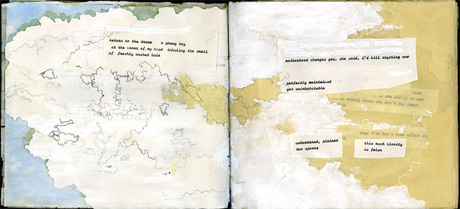
Jen Bervin, A Non-Breaking Space. Poetry/ Artist Book, web-only. Ugly Duckling Presse, 2005. Single signature of rice paper with white bond paper and carbon paper. Gesso, gouache, ink, pencil, cursive typewriter text and typewriter opaquing film. Unbound. Dimensions open: 7.5" h x 18.5" w. 56 unnumbered pages.
MD: If the landscape of poetry is changing, are we rethinking what publication means? Has poetry defined alternatives for itself, instead of in relation to a market dominated by prose genres?
NK: The landscape of what might be called alternative poetry publishing currently reflects a wide range of possibilities along a spectrum—everything from Web-only works, simple PDF chapbooks readers find online and then print and bind themselves, to traditionally handprinted books made in very small editions, to elaborately crafted one-of-a-kind artist’s books. And these, of course, are just a few obvious possibilities. Poets, artists, and bookmakers use these and other publication models, creating countless combinations and variations, and frequently generating new publication formats.
No matter the scale, any of these alternatives to more commercial publication methods might provide the writer or publisher with new ways to imagine how poetry works. Writers who create their own publishing formats can end up writing to those formats. By taking the means of production into one’s own hands, a poet can imagine new kinds of writing that might not otherwise be possible. The poet Suzanne Heyd’s recent work comes to mind for me; Phylum Press published a chapbook of her work called Crawl Space, which is based on a handmade, limited edition of the poems that Heyd composed individually on commercially produced paint samples (the kind you find at Home Depot) with a typewriter. If she had been writing longhand or on a word processor, the poems would likely have been very different.
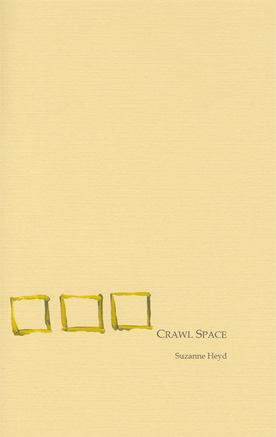
Crawl Space (2007, Phylum Press)
MD: If a generation of poets and readers are eager to experience poetry in a different and personal way, what does that mean for the future of poetry?
NK: I do think it is clear that there is a strong and growing interest in alternatives to commercial publishing in poetry communities. That this interest is often coincident with an interest in broader book arts has resulted in a vast and growing body of compelling and often beautiful book works exploring the literary and aesthetic implications of different publishing models and the relationships between poetry and more visual and tactile art forms. And the notion that “form is content” is evident everywhere in this work, as poets and bookmakers create book works and textual objects in which the text is inextricable from its medium.
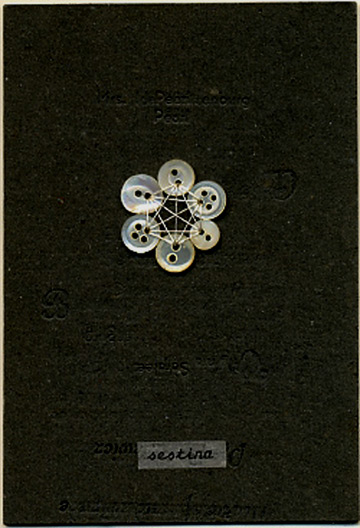
Jen Bervin, Button Sestina. Printer’s backing board, thread, abalone buttons, silk tissue, hand-typed text. 5" h x 3.5" w. 2001, 2003.
AM: This growing tendency for poets to engage more deeply not only in the construction of their works, but also in the way their poetry is presented, would give them one more way through which to guide an audience’s experience of their work. How have Phylum Press and the poets with whom you’ve worked approached this?
NK: The simple forms of our publications—short pamphlets and chapbooks—may not seem likely to dramatically change the readers’ broader understanding of the text. Nevertheless, we take care with the physical presentation of our publications in an effort to demonstrate the value we place on the texts they contain. We work closely with our poets to make books that they feel present their work in a way they find appropriate and meaningful. In spite of their somewhat ephemeral formats, all our books are hand bound and decorated. Sometimes each copy is individually painted, as in the case of Suzanne Heyd’s Crawl Space and Graham Foust’s 6; or stamped, as with Joel Bettridge’s Shores and Elizabeth Robinson’s Golem; or screen printed, as with Jae Jennifer Rossman’s cover for Dear Blank. The writers sign each copy, so they have literally handled the entire edition. In this way, the physical publication can convey to readers a kind of immediacy and intimacy.
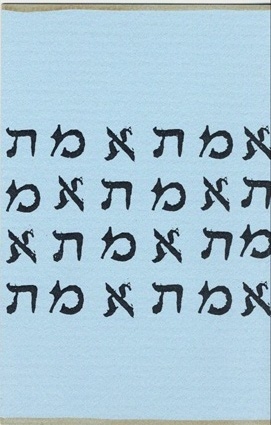
The Golem (2007, Phylum Press)
MD: This, once again, takes us back to the role of the audience.
JB: The more we keep those shaping forces inside the work itself, the better we might find the form the work needs. Answering that question first, prior to thinking about how a work might be conveyed to an audience or fit on a shelf, seems very important. It could start with a need for a different sort of space: Is the paper you use 12 feet square? Is the poem typed by a plane, like David Antin’s sky poem? What if your sole medium of the poem is memorization and recitation (a very old medium)? These choices can affect the experience of writing a poem, the nature of the poems written, and their relationship to the audience. My recent book The Desert is a fairly extreme example of this trajectory, [as is,] earlier, The Red Box.
AM: This, then, is how poetry continues to reinvent itself. Poets find the specific kind of space the poem demands, right? Poetry, therefore, continues to take on new forms and can vary quite dramatically from poet to poet. This also brings up the question of process. That is, when and how do you discover what space these poems belong in?
JB: I just work and work until it feels alive and itself. When something’s forming, I can’t stay away. It just keeps happening. I experience the process of poem-making as a kind of restlessness—that the poem/book is uncomfortable and jangling if it’s not done. I come back to things. Trying to get sound or thoughts to look like space is always an odd thing, even in the most pared-down spaces.
MD: Jen, I understand that your entry into poetry was preceded by training in more visual forms of art, and I’m curious as to how that affects your construction of space.
JB: My training as an artist at the School of the Art Institute of Chicago involved a lot of scrutinizing—of ideas, intent, form, materials, contexts—so much so that I imagine that sort of inner dialogue goes straight through the life of a project. I’m making a lot of choices about the space and everything else, but it rarely feels like it. Everything starts moving in certain directions out of necessary response, or what Josef Albers would call “thinking in situations.”
AM: This kind of restlessness seems to suggest getting lost in the process, discovering unexpected ideas and answering unforeseen questions.
JB: I do love getting lost, having new questions come up. But I usually start in the page space I plan to stay in (or something similar). When I think I’m nearly done, I often try to dislocate a work (read it aloud, record it, read it backward linearly, type it out, etc.)—not because I think it should be in a different form, but because it helps me see it afresh to edit it. The choices to be made about structure, format, materials, publishing, etc., can change things inside the poem. But that’s more adjustment and response. Moving through a number of iterations of full mock-ups can be very useful. Others can tell you what you’re actually communicating, which can help you get closer to shaping the experience of a work that you want to give.
MD: Though works that join the visual with the verbal are growing in popularity, they still seem fairly rare. Do you see this becoming the new, accepted norm for the presentation of poetic works? Should new or beginning poets start mastering multiple genres of art if we are to thrive in the poetic world?
NK: I am not sure I agree that there is any great pressure for poets to pursue more visual ways of working. I think more traditional modes of publishing and printing are still quite dominant on the poetry scene, and I suspect that many, if not most, beginning poets don’t have any ambition to see their work published in ways that emphasize the combination of verbal, visual, and tactical metaphor making in the way that, say, much of Jen’s work does. That said, work like Jen’s—and Jen’s specifically—is already widely accepted and valued for the ways it pushes us as readers to reimagine the ways poetry might work and inspires us as writers to consider new ways of working with language and new poetic forms, even if we aren’t skilled in the visual arts.
JB: I hope no one feels pressured to work the way I do. It’s just been the only way I could proceed and make sense to myself.
NK: Jen, I like so much what you’ve said about choices in structure, format, editions, and “adjustment and response.” The same might be said of drafting and revision both at the level of the text and at the level of physical form. And, too, it seems it might apply even more broadly to various alternatives to more conventional publishing. Aren’t all the different kinds of ways we might push poetry, the different forms and formats, in part about adjustment and response?


